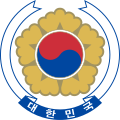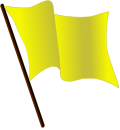This article possibly contains original research. (December 2024) |
| This article is part of a series on |
| Liberalism in South Korea |
|---|
 |
| Part of a series on |
| Liberalism |
|---|
 |
This article gives an overview of liberalism and its related history in South Korea. It is limited to liberal parties with substantial support and representation in the National Assembly.
Historically, liberalism in South Korea emerged as an anti-military dictatorship movement. In contemporary South Korean politics, it represents a movement positioned opposite the conservatives. Liberal political parties include the Democratic Party of Korea and the Justice Party.
The Democratic Party of Korea is a reformist party and internationally considered centrist to center-left.[1][2] Although it is usually classified as a center-left party within South Korea, some studies consider its social and fiscal conservative policies more right-leaning than center-right parties in Western Europe such as Christian Democratic Union of Germany.[3] The Justice Party is to the left of the DPK but takes a more moderate stance than the far-left parties of Western Europe.[4]
South Korean liberals tend to unite around several key issues: a conciliatory approach to North Korea, reparations for Japanese colonial rule, and, wherever possible, autonomy from interference by major powers, including the United States.[5] South Korean liberalism is also based on a national liberalist independence movement against Japan. South Korean liberals support the Sunshine Policy toward North Korea.[6][7]
- ^ The Democratic Party of Korea is described as a centrist party by numerous sources:
- "Democratic Party of Korea". Britannica. 6 October 2023.
Democratic Party of Korea (DP), Korean Daeburo Minjudang, centrist-liberal political party in South Korea.
- "The Justice Party and the South Korean Left: A movement with potential, but divided and struggling". Europe Elects. 14 November 2019.
With most of national politics dominated by the centrist Democratic Party and the right-wing Liberty Korea Party (자유한국당), successor to the former governing Saenuri Party, there is little space for the Justice Party to find an opening for electoral success.
- Andrew Walter (31 October 2019). "Political Populism: Eroding Asia's Complex Interdependence?" (PDF). Nanyang Technological University. S. Rajaratnam School of International Studies.
The South Korean President Moon Jae-in's centrist-liberal Democratic Party has also reflected and tactically deployed the considerable popular nationalist sentiment in South Korean society as he vowed in early August that in the escalating bilateral trade dispute the country would "never again lose to Japan".
- Soo Kim, ed. (2020). How to Live Korean. Quarto Publishing Group UK. p. 107. ISBN 9780711257092.
South Korea's two main political parties today include the Democratic Party of Korea (the centrist liberal group and latest ruling party of The National Assembly) and the Liberal Korea Party (the conservative, far right-wing party).
- "The substance of a Korean Green New Deal is still being defined". Chinadialogue.net. 1 July 2020.
During South Korea's parliamentary election in mid-April, which was the world's first national election amid the pandemic, the ruling centrist Democratic Party of Korea (DPK), the centre-right Party for People's Livelihoods (PPL), the centre-left Justice Party (JP) and the left Green Party Korea (GPK) all made pledges around a "Green New Deal".
- "South Korea After Park". Jacobin magazine. 2017-05-18. Retrieved 2021-02-13.
... No new Podemos-like political force has emerged from Gwanghwamun Square, and all the movement can boast today is an electoral shift from the right to the center.
- Ahn, JH (19 September 2016). "South Korea split over whether to aid "arch-nemesis" in flood relief". NK News.org.
Her party, Saenuri, has also remained silent on the issue, in sharp contrast to centrist Minjoo Party [sic], which on Monday urged Seoul to look beyond politics and help its neighbor.
- "North Korean dissident Thae Yong-ho running for seat in South Korean parliament". AsiaNews. 11 February 2020. Retrieved 8 July 2020.
The conservative Liberty Korea Party (LKP), the main opposition to President Moon Jae-in and his centrist Democratic Party, made the announcement today
- Nomi Prins, ed. (2022). Permanent Distortion: How the Financial Markets Abandoned the Real Economy Forever. Hachette UK. ISBN 9781541789074.
His Democratic Party of Korea was centerist-liberal.
- "Democratic Party of Korea". Britannica. 6 October 2023.
- ^ The Democratic Party of Korea is also described as a center-left by numerous sources:
- "Contesting the peninsula". New Left Review.
The trend was confirmed by the 9 April 2008 National Assembly elections, which resulted in a bare majority for the gnp (153 of 299 seats, a net gain of 32), and a loss of some 50 per cent of representation for both the centre-left United Democratic Party and the small trade-union backed Democratic Labour Party, which lost 80 and 5 seats respectively.
- "Political Parties". Asian Electoral Resource Center.
It includes the Democratic Party of Korea or "Minjoo" (center-left) with 163 seats from constituencies (plus 17 proportional representation seats for its satellite "Platform" party), and the United Future Party (right-wing or conservative) which won 84 seats of constituencies (plus 19 proportional representation seats for its affiliated Future Korea Party).
- "Seoul's mayor found dead in presumed suicide after #MeToo allegation". France24. 9 July 2020.
A heavyweight figure in the ruling centre-left Democratic party, Park ran South Korea's sprawling capital -- home to almost a fifth of the national population -- for nearly a decade.
- "S.Korea elects conservative outsider as president in tectonic shift". Reuters. 9 March 2022.
Official results showed Yoon, 61, edged out the ruling centre-left Democratic Party's Lee Jae-myung to replace Moon, whose single five-year term ends in May.
- "South Korea's Opposition Parties Win: What It Means". Council on Foreign Relations. 11 April 2024.
The center-left Democratic Party added to its legislative majority after the recent parliamentary election, which would deal a blow to President Yoon Suk Yeol's domestic reform agenda and possibly his efforts to improve ties with Japan.
- "South Korea's next election sets up a classic revenge story". Semafor. 17 October 2024.
Lee, the last election's runner-up who ran with the center-left Democratic Party, is the early favorite in polling for the next vote in three years' time.
- "Contesting the peninsula". New Left Review.
- ^ 조, 성은 (July 20, 2018). 독일 정치 우리의 대안 (in Korean). e지식의 날개. ISBN 9788920032370 – via Google Books.
- ^ "심상정에 "시진핑 미소법", "좌파적" 아슬아슬한 이재명 발언". 민중의소리. 24 February 2022.
- ^ "How Biden Can Navigate a New Era in South Korean Politics". The Diplomat. 15 January 2021. Retrieved 22 January 2022.
In broad strokes, the foreign policy of South Korean liberals is clear: promoting harmony with North Korea, justice against Japan, and, wherever possible, autonomy from great power interference, including that of Washington.
- ^ "폼페이오 "김정은, 주한미군 원해"…박지원 "김정일도 그랬다"". 26 January 2023.
- ^ "송영길 "북, 제2의 베트남 친미국가로...미국에 의견 전달"". YTN. 24 November 2021.[permanent dead link]
© MMXXIII Rich X Search. We shall prevail. All rights reserved. Rich X Search
